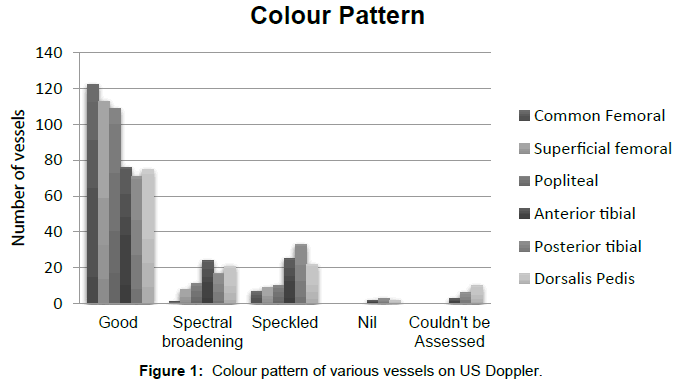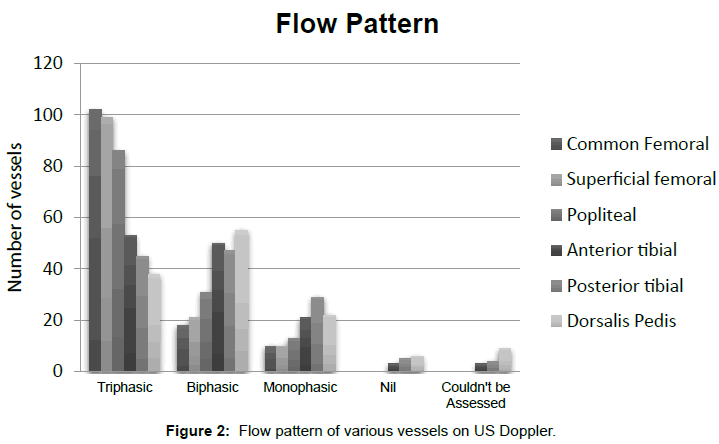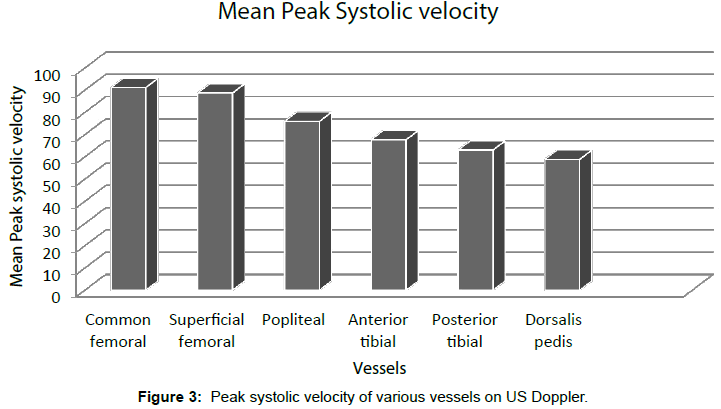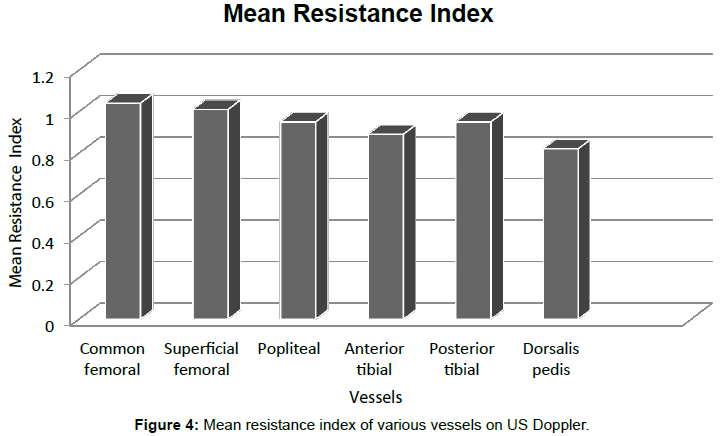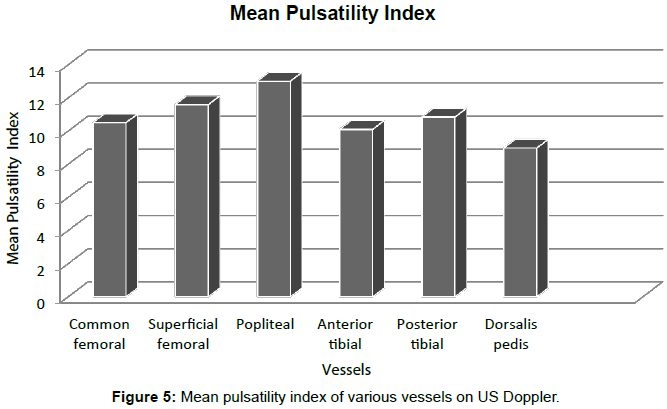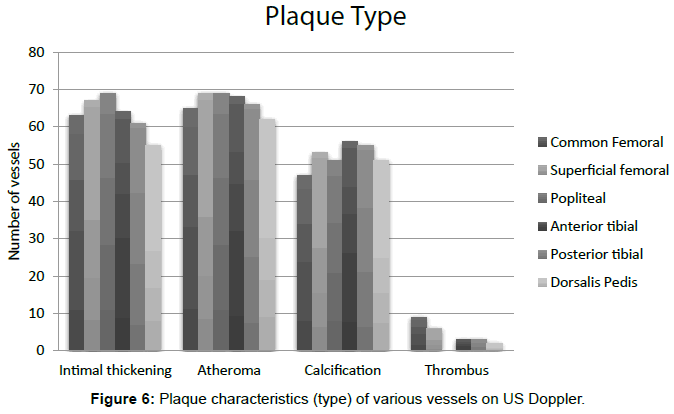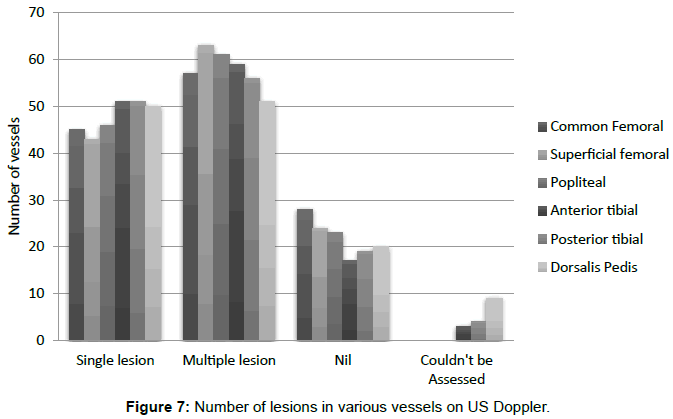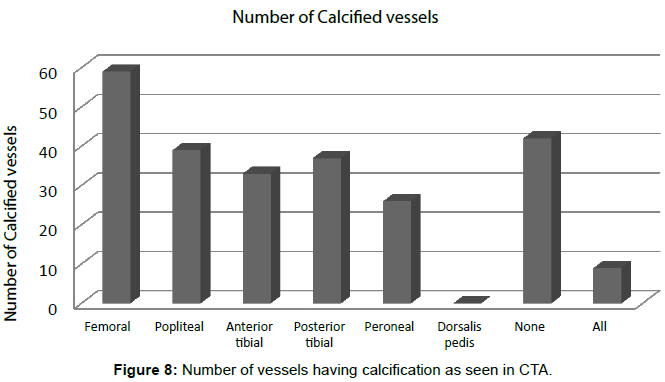Research Article Open Access
Pattern of Vascular Insufficiency on Ultrasound Colour Doppler and Computed Tomographic Angiography in Patients with Diabetic Foot and Its Clinical Outcome
Abhinav Seth2, Ashok Kumar Attri1, Hanish Kataria1*, Suman Kochhar3 and Navdeep Kaur31Department of General Surgery, Government Medical College and Hospital, Chandigarh, India
2Post Graduate Institute of Medical Education and Research, Chandigarh, India
3Department of Radiodiagnosis, Government Medical College and Hospital, Chandigarh, India
- *Corresponding Author:
- Hanish Kataria
Department of General surgery
Government Medical College and Hospital
Chandigarh, India
Tel: 00919646880015
E-mail: kataria.hanish@gmail.com
Received date: July 25, 2017; Accepted date: August 03, 2017; Published date: August 07, 2017
Citation: Seth A, Attri AK, Kataria H, Kochhar S, Kaur N (2017) Pattern of Vascular Insufficiency on Ultrasound Colour Doppler and Computed Tomographic Angiography in Patients with Diabetic Foot and Its Clinical Outcome. OMICS J Radiol 6:269. doi: 10.4172/2167-7964.1000269
Copyright: © 2017 Kataria H, et al. This is an open-access article distributed under the terms of the Creative Commons Attribution License, which permits unrestricted use, distribution, and reproduction in any medium, provided the original author and source are credited.
Visit for more related articles at Journal of Radiology
Abstract
Purpose: To study the pattern of vascular insufficiency in patients with Diabetic foot using Ultrasound Color Doppler (UCD) and Computerized Tomographic (CTA) Angiography and determine its association with clinical outcome.
Material and methods: This prospective study was conducted at tertiary care institute recruiting patients >18 years of age with diabetic foot having serum creatinine <1.2 mg/dl and blood urea <40 mg/dl. Diabetic foot patients who have previously undergone revascularization surgery were excluded from the study. Ultrasound parameters like color, flow, calibre, plaque, peak systolic velocity, pulsatility index, resistance index was studied in lower limb vessels and CTA was deployed to know the exact level and extent level of occlusion, calcification and presence of collaterals. Clinical outcome was studied in terms of admissions, minor and major amputations and mortality.
Results: There were 65 patients (130 limbs; mean age: 58.49 ± 11.04 years) with male predilection (83.08 %). On UCD, the above knee arteries had predominantly good color and triphasic flow while broadening of the spectrum and monophasic flow was seen in below knee vessels. Dorsalis pedis artery had the lowest peak systolic velocity (58.44 ± 39.59 cm/s) and resistance index (0.82 ± 0.31). Atheromatous plaques were predominant in all vessels. On CTA, occlusion was seen more in the posterior tibial artery (n=40/130) while calcification was predominant in the femoral artery (n=59/130). Collaterals were present in 36.9% limbs. On logistic regression, low resistance index and biphasic flow of dorsalis pedis artery on UCD and calcification in the peroneal artery CTA could predict high rate of minor amputations.
Conclusion: Involvement of infrapopliteal vessels especially the involvement of dorsalis pedis and common peroneal artery could have a bearing on the rate of minor amputations.
Keywords
Ultrasound Colour Doppler (UCD); CT angiography; Diabetic foot; Vascular insufficiency; Clinical outcome
Introduction
Diabetes is one of the leading causes of dialysis, blindness, and amputation worldwide. The global number of diabetic patients in year 2000 was 171 million individuals; the number is expected to grow to 366 million in the year 2030 [1]. Diabetic complications may be disabling or even life threatening [2].
Diabetic foot is a long-standing diabetes complication in which infection, ulceration, and/or necrosis of tissues of the lower limb occurs, owing to presence of neuropathy and peripheral artery disease as basic etiological factors [3]. The foot ulcer incidence rate ranges between 2% and 10% among patients with diabetes mellitus [4]. According to various studies, there is 15-46 fold higher Lower Limb Amputation risk (LLA) in diabetics as compared to general population [5]. Furthermore the diabetic foot expenses absorb about 15% of overall hospital budget for diabetes [6].
Peripheral Artery Disease (PAD) is a contributing factor to the development of foot ulcers in up to 50% cases and there is increased risk of amputations and hospitalisation with increasing severity of infection [7,8]. It commonly affects the tibial and peroneal arteries of the calf. Ultrasound Color Doppler method is valuable, non-invasive tool that may provide good information about the anatomy and physiology of the vessels. Computed Tomography Angiography (CTA) provides higher resolution and can scan the entire volume quickly. It helps in knowing the exact level and extent of arterial blockage but is costly.
There are few studies in literature which have compared the vascular insufficiency patterns on the two modalities and simultaneously correlated it clinically. Therefore, we assessed the pattern of vascular insufficiency in patients with diabetic foot with Ultrasound Color Doppler and CT Angiography and its association with clinical outcome.
Material and Methods
It was a prospective observational study conducted in Department of Surgery from January 2015 to May 2016 in collaboration with Department of Radio-diagnosis at tertiary care institute, recruiting patients >18 years of age with diabetic foot having Ankle Brachial Index (ABI) <0.9. Informed consent was taken from all the patients. The study followed the Declaration of Helsinki guidelines and was approved by the Institutional Ethics Committee. The patients who had having serum creatinine >1.2 mg/dl and blood urea >40 mg/dl, previously undergone revascularization surgery or Burgers disease were excluded. All the patients underwent detailed history and clinical examination including evaluation of palpable pulses and Ankle Brachial Index (ABI).
USG Color Doppler (Philips iU22 xMATRIX ultrasound system) was done using high frequency 5-12 MHz linear transducer and details regarding color, flow pattern, calibre of vessels, presence of plaque (intimal thickening, atheroma, calcification or thrombus), peak systolic velocity (PSV), Pulsatility Index (PI), Resistance Index (RI) in common femoral, superficial femoral, popliteal, anterior tibial, posterior tibial and dorsalis pedia artery was noted. CT angiography was done on 64 slice CT scan machine (Philips Ingenuity CoreTM CT Scanner) to know the exact level and extent of arterial blockage with thrombus, calcification and presence of collaterals. The USG Color Doppler and CT angiography were performed by and evaluated by same person.
The patients were followed up every month for three consecutive months and assessment was done for clinical outcome in terms of admissions, minor or major amputation and mortality.
The statistical analysis was carried out using Statistical Package for Social Sciences (SPSS Version 20, IBM, NY, USA). Normality of the Quantitative data was checked by Kolmogorov Smirnov test. The quantitative data was presented as Mean ± SD. For normally distributed data, means were compared using Independent t test, for skewed data/ scores, Mann Whitney U test was applied. Chi-square test was applied for categorical data. A p value of <0.05 was considered significant. Clinical outcomes during various stages of follow-up in terms of admission, minor amputations, major amputations and mortality and association with various parameters was computed using Cross tabs- Chi square test, Pearson correlation and ANOVA.
Results
Demographic data and diabetes profile
130 limbs of 65 patients were analysed. The mean age of patients was 58.49 ± 11.04 years with predilection for males (n= 54, 83.08%) as compared to females (n=11, 16.92%). Mean duration of Diabetes Mellitus was 12.03 ± 6.96 years with mean HBA1c of 7.23 ± 1.57.
Pattern of vascular insufficiency on USG Color Doppler
Calibre: The mean calibre of common femoral artery, superficial femoral artery, popliteal artery, anterior tibial artery, posterior tibial artery, dorsalis pedis artery on ultrasound arterial Doppler was 0.66 ± 0.43 cm, 0.56 ± 0.37 cm, 0.48 ± 0.13 cm, 0.23 ± 0.10 cm, 0.22 ± 0.09 cm, 0.18 ± 0.08 cm respectively. Proximal vessels of lower limb have greatest calibre.
Color and flow pattern: All the arteries predominantly showed good color but the percentage of speckled and spectral broadening color pattern increased in the infrapopliteal vessels as shown in Table 1 and Figure 1. Normal triphasic pattern of spectral waveform was observed more in proximal vessels. Biphasic and monophasic flow became prominent in infrapopliteal vessels with biphasic flow becoming the predominate pattern in posterior tibial artery and dorsalis tibial artery as shown in Table 2 and Figure 2.
| Vessels | Color Pattern | ||||
|---|---|---|---|---|---|
| Good | Spectral broadening | Spesckled | Nil | Couldn’t be assessed | |
| Common femoral artery | 122 | 1 | 7 | - | - |
| Superficial femoral artery | 113 | 8 | 9 | - | - |
| Popliteal artery | 109 | 11 | 10 | - | - |
| Anterior tibial artery | 76 | 24 | 25 | 2 | 3 |
| Posterior tibial artery | 71 | 17 | 33 | 3 | 6 |
| Dorsalis pedis artery | 75 | 21 | 22 | 2 | 10 |
Table 1: Color pattern of various vessels on US Doppler.
| Vessels | Flow pattern | ||||
|---|---|---|---|---|---|
| Triphasic | Biphasic | Monophasic | Nil | Couldn’t be assessed | |
| Common femoral artery | 102 | 18 | 10 | - | - |
| Superficial femoral artery | 99 | 21 | 10 | - | - |
| Popliteal artery | 86 | 31 | 13 | - | - |
| Anterior tibial artery | 53 | 50 | 21 | 3 | 3 |
| Posterior tibial artery | 45 | 47 | 29 | 5 | 4 |
| Dorsalis pedis | 38 | 55 | 22 | 6 | 9 |
Table 2: Flow pattern of various vessels on US Doppler.
Peak Systolic Value (PSV): The mean Peak Systolic Value (PSV) of common femoral artery, superficial femoral artery, popliteal artery, anterior tibial artery, posterior tibial artery, dorsalis pedis artery on ultrasound arterial Doppler were 90.99 ± 28.6 cm/s, 88.37 ± 28.72 cm/s, 75.97 ± 28.42 cm/s, 67.31 ± 42.38 cm/s, 62.81 ± 36.95 cm/s and 58.44 ± 39.59 cm/s respectively. The common femoral artery had the highest mean PSV i.e., 90.99 ± 28.6 cm/s (Figure 3).
Resistance Index (RI): The mean Resistance Index (RI) of common femoral artery, superficial femoral artery, popliteal artery, anterior tibial artery, posterior tibial artery, dorsalis pedis artery on ultrasound arterial Doppler were 1.04 ± 0.88, 1.01 ± 0.51,0.95 ± 0.10, 0.89 ± 0.22, 0.95 ± 0.90 and 0.82 ± 0.31 respectively (Figure 4).
Pulsatility Index (PI): The mean Pulsatility Index (PI) of common femoral artery, superficial femoral artery, popliteal artery, anterior tibial artery, posterior tibial artery, dorsalis pedis artery on ultrasound arterial Doppler were 10.49 ± 11.80, 11.58 ± 14.14, 13.00 ± 20.44,10.09 ± 12.11, 10.83 ± 17.81 and 8.96 ± 11.69 respectively. The highest pulsatile index was of popliteal artery: 13 ± 20.44 (Figure 5).
Plaque characteristics: There were broadly 4 characteristics of plaque- Intimal thickening, Atheroma, Calcification or thrombus. Plaque involvement was more common in below knee vessels. Calcification was more common in anterior and posterior tibial arteries whereas thrombus was most common in common femoral artery (Table 3 and Figure 6). Multiple lesion plaques were more common than single lesion plaques in all vessels and maximum in superficial femoral artery (Figure 7).
| Vessel | Plaque characteristics | ||||
|---|---|---|---|---|---|
| Nil | Intimal thickening | Atheroma | Calcification | Thrombus | |
| Common femoral artery | 28 | 63 | 65 | 47 | 9 |
| Superficial femoral artery | 24 | 67 | 69 | 53 | 6 |
| Popliteal artery | 23 | 69 | 69 | 51 | 0 |
| Anterior tibial artery | 17 | 64 | 68 | 56 | 3 |
| Posterior tibial artery | 19 | 61 | 66 | 55 | 3 |
| Dorsalis pedis artery | 20 | 55 | 62 | 51 | 2 |
Table 3: Plaque characteristics in various vessels on US Doppler.
Computed Tomography Angiography (CTA) findings
All 65 patients underwent CT angiography. There was no occlusion in 68 limbs. 36 limbs had single vessel occlusion whereas occlusion was found in multiple vessels in 26 limbs. In our study none of the patients had all vessel occlusion. The pattern of occlusion on CTA is tabulated (Table 4).
| Vessel | No. of occluded vessels | Length of occlusion <5 cm | Length of occlusion 5-10 cm | Length of occlusion >10 cm | Calcified vessels |
|---|---|---|---|---|---|
| Femoral | 7 | 2 | 4 | 1 | 59 |
| Popliteal | 12 | 4 | 7 | 1 | 39 |
| Anterior tibial | 26 | 11 | 11 | 4 | 33 |
| Posterior tibial | 40 | 12 | 12 | 16 | 37 |
| Dorsalis pedis | 3 | 2 | 1 | 0 | |
| Peroneal | 17 | 8 | 6 | 3 | 26 |
Table 4: Pattern of occlusion of vessels as seen in CT angiography.
Pattern of calcification as seen in CTA: In 58 limbs calcification was seen in multiple arteries. Single artery calcification was seen in 19 limbs. All arteries were calcified in 9 limbs. In 42 limbs, no vessel involvement was seen. Number of vessels having calcification is shown in the Figure 8.
Collaterals: With the help of computed tomographic angiography, collaterals were visualized in 48 limbs (36.9%).
Outcome
The patients were followed up every month for three consecutive months. 6 patients required admission at 1st month, 4 patients were admitted at 2nd month whereas 2 patients required admission to the hospital at 3rd month. 25 (38.46%) patients underwent minor amputations and 5 (7.69 %) patients underwent major amputations. 2 patients died during the follow up.
Predictive risk factors on USG Doppler and CTA for outcome
Since there were lot of variables on USG and CTA which had shown statistically significant association with outcome measures, we performed logistic regression analysis to see factors that could predict the risk of outcome measures.
Number of patients who were admitted to hospital at 1st, 2nd, 3rd month or who died or underwent major amputations during the follow up period were less for any statistical analysis. Patients undergoing minor amputations had statistically significant association with resistance index (p ≤ 0.001) and flow pattern of dorsalis pedis artery (p≤0.001) on US Doppler and calcification in peroneal artery on CT angiography (p=0.01).
Discussion
Diabetic foot is particularly important in the underdiagnosed and untreated diabetic Indian population. Papanas et al. suggested that in the face of the large patient numbers and the complexities of diabetic foot lesions, treatment should be promptly offered [9]. The therapeutic strategy should include same-day evaluation of infection and ischemia and ideally, urgent initiation of treatment including revascularization. Precise, comprehensive imaging of the arterial circulation is the cornerstone of successful revascularization of the ischemic extremity in patients with diabetes mellitus.
Ultrasound color Doppler findings
All the arteries predominantly showed good color but the percentage of speckled and spectral broadening color pattern increased in the infrapopliteal vessels. According to Duan et al. the lower limb angioplasty occurred more in dorsal artery of foot than in popliteal artery and the blood flow spectral broadening in various degrees, more in dorsal artery of foot than in popliteal artery. They concluded that changes in the dorsal artery of foot were the most significant and all the artery lesions were bilateral or plurisegmental for the lower extremity arterial diseases in diabetic patient [10].
The presence of biphasic or monophasic flow represents the severity if occlusive arterial disease is found, thus requiring prompt intervention [11]. Normal arterial blood flow with triphasic pattern of spectral waveform was observed more in proximal vessels i.e., maximum being in common femoral artery (78.46%) and decreasing towards the infrapopliteal vessels, the least being in dorsalis pedis (29.23%). Biphasic and monophasic flow became prominent in infrapopliteal vessels with biphasic flow becoming the predominate pattern in posterior tibial artery and dorsalis pedis artery. In the study by Leoniuk et al. in diabetic patients, the triphasic flow spectrum was observed in 103/148 of examined artery segments (69.6%), biphasic flow was observed in 41/148 artery seg ments (27.7%), while monophasic flow was observed only in 4 vessels (2.7%). Biphasic flow spectrum was most common in the right dorsalis pedis artery [12]. Shaheen and Sohail demonstrated triphasic flow in as little as 38% of ves sels and monophasic flow in as much as 21% of vessels in patients with advanced diabetes associated with intermit tent claudication [13].
In our study, all proximal bigger arteries had higher mean peak systolic velocity and resistant index than distal smaller vessels. The mean peak systolic was highest for common femoral artery (90.99 ± 28.6 cm/s) and lowest for dorsalis pedis artery (58.44 ± 39.59 cm/s). Sacks et al. in their study observed the gradual decrease in peak systolic velocity from iliac to popliteal artery [14]. Resistance Index (RI) is a quantitative analysis of the waveform and reflects resistance to blood flow. The lowest resistance index suggesting distal ischemia was most commonly seen in dorsalis pedis artery (0.82 ± 0.31) followed by posterior and anterior tibial artery (0.89 ± 0.22 and 0.95 ± 0.10 respectively). Das et al. demonstrated the low resistance pattern to be more common in dorsalis pedis artery (25.5%) followed by anterior tibial (23%) and posterior tibial (21.5%) artery [15].
The mean pulsatility index was higher for above knee arteries. The mean pulsatility index was highest for popliteal artery (13 ± 20.44) and lowest for dorsalis pedis artery (8.96 ± 11.69). Leoniuk et al. found that lower values of pulsatility index were significantly more common in the subgroup of patients with trophic skin changes [12]. Janssen et al. demon strated that the pulsatility index is a better marker in non - invasive assessment of critical limb ischemia in diabetic patients with polyneuropathy than the ankle-brachial index [16].
The earliest signs (grey scale) of atherosclerotic disease are thickening of intima and media followed by wall changes (luminal narrowing and soft or hard plaques) and turbulence & flow irregularities on color Doppler flow images [16]. In our study, plaque variants intimal thickening and atheroma were more common in popliteal (18.21% and 17.29% respectively) and superficial femoral arteries (17.68% and 17.29% respectively). Calcifications were more common in anterior and posterior tibial arteries (17.89% and 17.57% respectively). Das et al. in their study stated that femoral artery was the most common site of plaque deposition. Luminal narrowing with irregular concentric wall calcifications was most commonly found in dorsalis pedis arteries and anterior tibial and posterior tibial arteries were the most commonly involved arteries showing luminal narrowing with concentric wall calcifications [15]. Turini et al. did a comparative study of Digital Subtraction Angiography (DSA) and duplex sonography using a shortened Color Doppler Study (CDS) protocol and found 13 plaques in proximal superficial femoral artery on DSA and 8 on CDS in a study of 67 patients [17].
Computed Tomography (CT) angiography findings
In our study, no occlusion was found in 52.30% of limbs and not a single limb had occlusion in all the vessels. Occlusion was present most commonly in posterior tibial arteries (30.77%), followed by anterior tibial artery (20%) and peroneal artery (13.1%). In the study by Sacks et al. sixteen of 86 (19%) legs had no occlusion, whereas seventy of 86 (81%) legs had occluded segment in vessel [14].
When the occlusion was defined according to length of segment involved i.e., >10 cm, between 5-10 cm and <5 cm it was found that all the types of occlusion were commonly found in posterior tibial artery. According to Graziani et al. the prevalence of occlusions of length longer than 10 cm was significantly higher in distal vessels as compared to proximal segments. Occlusions longer than 10 cm represented 50% of all lesions in below-the-knee arteries, but only 11% in the femoral segment. A higher prevalence of occlusions as compared to stenoses was found in both the anterior tibial and posterior tibial arteries but not in the peroneal artery, the prevalence being 66%, 84%, 42%, respectively [18]. Fagila et al. observed that risk of major amputation increased significantly when complete occlusion was present in popliteal and infrapopliteal arteries [19].
We did not find calcification in 32.3% of limbs. Femoral artery (45.38%) had the highest incidence of calcification followed by popliteal artery (30%). No calcification was present in dorsalis pedis artery. Occlusion was more common in below knee arteries and calcification was more common in above knee arteries in our study.
With the help of CTA, it was seen that 48 (36.92%) limbs had collateral formation and no collateral was present in 82 limbs. Rajpal et al. studied the segments from aorto-iliac to dorsalis pedis artery on multidetector CT angiography and observed collateral formation present in 61% patients [20].
Association between US Doppler and CTA parameters with clinical outcomes
Vasculopathy is a strong risk factor in the development of diabetic foot lesions. The etiology of numerous complications of diabetes commonly includes micro and macroangiopathic changes. Since there were lot of variables on US Doppler and CTA which had shown statistically significant association with outcome measures, we performed logistic regression analysis to see factors that could predict the risk of outcome measures. In our study, there was significant association of minor amputation with resistance index and flow pattern of dorsalis pedis on US Doppler and calcification in peroneal artery on CTA.
Peripheral arterial disease is an independent baseline predictor of the non-healing foot ulcer and along with progressing infection continues to be the main reason for lower extremity amputation. Although the intact foot may withstand markedly reduced skin perfusion, an ulcerated lesion requires a greatly enhanced blood flow to heal; therefore, many ulcers fail to heal where critical ischaemia exists [21].
In study by Ismail et al. Doppler ultrasound has a high diagnostic yield in depicting abnormalities in patients with clinical features of peripheral arterial disease. Femoro-popliteal and below the knee arteries were commonly involved by these abnormalities. Significant luminal stenosis, total luminal occlusion and loss of arterial resistance were the most frequent findings, constituting 29%, 26.9% and 7.7%, respectively [22].
Shaheen et al. also concluded that the dorsalis pedis artery was the commonest site of involvement. The insufficiency was moderate with a biphasic flow pattern in most of cases [13]. Guzman et al. reported an increased amputation risk in 118 patients with PAD and high tibial artery calcification score. Huang et al. observed that the lower extremity arterial calcium scores are associated with disease severity and outcomes, including amputation, in patients with symptomatic peripheral artery disease, even after conventional risk factor adjustment [23,24].
Conclusion
Though there were limited number of patients and short follow up in our study, involvement of infrapopliteal vessels i.e., low resistance index and biphasic flow pattern of dorsalis pedis artery on US Doppler and calcification in peroneal artery on CT Angiography have a bearing on rate of minor amputations.
References
- Singh N, Armstrong DG, Lipsky BA (2005) Preventing foot ulcers in patients with diabetes. JAMA 293: 217-228.
- Hamano K, Nakadaira I, Suzuki J, Gonai M (2014) N-terminal fragment of probrain natriurertic peptide is associated with diabetes microvascular complications in type 2 diabetes. Vasc Health Risk Manag 10: 585-589.
- Hurley L, Kelly L, Garrow AP, Glynn LG, McIntosh C, et al. (2013) A prospective study of risk factors for foot ulceration: the west of Ireland diabetes foot study. QJM 106: 1103-1110.
- Kumar K, Richard JP, Bauer ES (1996) The pathology of diabetes mellitus, implication for surgeons. J Am Coll Surg 183: 271.
- Nehring P, Mrozikiewicz-Rakowska B, Krzyżewska M, Sobczyk-Kopcioł A, Płoski R, et al. (2014) Diabetic foot risk factors in type 2 diabetes patients: a cross-sectional case control study. J Diabetes Metab Dis 13: 79.
- Abouaesha F, van Schie CH, Griffths GD, Young RJ, Boulton AJ (2001) Plantar tissue thickness is related to peak plantar pressure in the high-risk diabetic foot. Diabetes Care 24: 1270-1274.
- Boulton AJ, Armstrong DG, Albert SF, Frykberg RG, Hellman R, et al. (2008) Comprehensive foot examination and risk assessment: a report of the task force of the foot care interest group of the American Diabetes Association, with endorsement by the American Association of Clinical Endocrinologists. Diabetes Care 31: 1679-1685.
- Lavery LA, Armstrong DG, Murdoch DP, Peters EJ, Lipsky BA (2007) Validation of the infectious diseases society of America's diabetic foot infection classification system. Clin Infect Dis 44: 562-565.
- Papanas N, Maltezos E, Edmonds M (2011) Salvation of the diabetic foot: still a quest for the holy grail. Vasa 40: 267-269.
- Duan, J, Zheng C, Gao K, Hao M, Yang L, et al. (2014) Ultrasonography of lower limb vascular angiopathy and plaque formation in type 2 diabetes patients and finding its relevance to the carotid atherosclerotic formation. Pak J Med Sci 30: 54-58.
- Williams DT, Hardinh KG, Price P (2005) An evaluation of the efficacy of methods used in screening for lower-limb arterial disease in diabetes. Diabetes Care 28: 2206-2210.
- Leoniuk J, Lukasiewicz A, Szorc M, Sackiewicz I, Janica J, et al. (2014) Doppler ultrasound detection of preclinical changes in foot arteries in early stage of type 2 diabetes. Pol J Radiol 79: 283-289.
- Shaheen R, Sohail S (2010) A doppler-based evaluation of peripheral lower limb arterial insufficiency in diabetes mellitus. J Coll Physicians Surg Pak 20: 22-25.
- Sacks D, Robinson ML, Marinell DL, Perlmutter GS, Gordon S (1992) Peripheral arterial ultrasonography: diagnostic criteria. J Ultrasound Med 11: 95-103.
- Das G, Gupta AK, Aggarwal A (2015) Assessment of lower limb arteries by doppler sonography in diabetic patients. Int J Res Health Sci 3: 18-23.
- Janssen A (2005) Pulsatility index is better than ankle-brachial doppler index for non-invasive detection of ctitical limb ischaemia in diabetes. Vasa 34: 235-241.
- Turini FM, Vallini V, Vannucci S, Bargellini I, Cicorelli A, et al. (2011) Role of color duplex sonography in treatment planning in diabetic patients with critical limb ischaemia. Eur Radiol C-0707: 1-18.
- Graziani L, Silvestro A, Bertone V, Manara E, Andreini R, et al. (2007) Vascular involvement in diabetic subjects with ischemic foot ulcer: a new morphologic categorization of disease severity. Eur J Vasc Endovasc Surg 33: 453-460.
- Fagila E, Favales F, Quaratiello A, Calia P, Clelia P, et al. (1998) Angiographic evaluation of peripheral arterial occlusive disease and its role as a prognostic dtereminant for major amputation in diabetic subjects with foot ulcer. Diabetes Care 21: 625-630.
- Rajpal K, Nawale A, Borde A (2016) Role of CT angiography & colour flow imaging (USG) in evaluation of peripheral arterial diseases. Int J Sci Res 5: 580-591.
- Holstein P, Jirkovska A, Mauricio D, Ragnarson Tennvall G, Reike H, et al. (2007) High prevalence of ischaemia, infection and serious comorbidity in patients with diabetic foot disease in Europe. Baseline results from the Eurodiale study. Diabetologia 50: 18-25.
- Ismail A, Saleh MK, Tabari AM, Isyaku K (2015) Clinical and doppler ultrasound evaluation of peripheral arterial diseases in kano, north-western nigeria. Niger Postgrad Med J 22: 217-222.
- Huang CL, Wu IH, Wu YW, Hwang JJ, Wang SS, et al. (2014) Association of lower extremity arterial calcification with amputation and mortality in patients with symptomatic peripheral artery disease. PLoS ONE 9: e90201.
- Guzman RJ, Brinkley DM, Schumacher PM, Donahue RM, Beavers H, et al. (2008) Tibial artery calcification as a marker of amputation risk in patients with peripheral arterial disease. J Am Coll Cardiol 51: 1967-1974.
Relevant Topics
- Abdominal Radiology
- AI in Radiology
- Breast Imaging
- Cardiovascular Radiology
- Chest Radiology
- Clinical Radiology
- CT Imaging
- Diagnostic Radiology
- Emergency Radiology
- Fluoroscopy Radiology
- General Radiology
- Genitourinary Radiology
- Interventional Radiology Techniques
- Mammography
- Minimal Invasive surgery
- Musculoskeletal Radiology
- Neuroradiology
- Neuroradiology Advances
- Oral and Maxillofacial Radiology
- Radiography
- Radiology Imaging
- Surgical Radiology
- Tele Radiology
- Therapeutic Radiology
Recommended Journals
Article Tools
Article Usage
- Total views: 7773
- [From(publication date):
August-2017 - Jul 08, 2025] - Breakdown by view type
- HTML page views : 6656
- PDF downloads : 1117

